June 20, 2025 | 10:11 GMT +7
June 20, 2025 | 10:11 GMT +7
Hotline: 0913.378.918
June 20, 2025 | 10:11 GMT +7
Hotline: 0913.378.918

GM corns are planted in An Giang. Photo: Thanh Son.
Nguyen Than Son, president of the Vietnam Poultry Association (VIPA), said that in recent years, along with the development of the livestock farming industry, the animal feed production sector in Vietnam has also seen a remarkable increase, with an average annual growth rate of 13-15 %.
He stated the figure during a webinar on August 12 co-hosted by the Foreign Agricultural Service (FAS) of the US Embassy in Vietnam, CropLife, and VIP on supplementing the animal feed supply for Vietnam's domestic market.
Until 2020, the overall output of animal feed was approximately 25 million tons, propelling Vietnam into the world's top 10 and Southeast Asia's leading positions in animal feed production.
Tran Ngoc Yen, the head of AgroMonitor, said that when farms and agricultural households combine their animal feed, the overall production countrywide must exceed 30 – 33 million tons.
VIPA predicted that the country's demand for animal feeds will reach 28-30 million tons per year in the next five years. Over half of the production (around 14-14.5 million tons) would be used for poultry farming.
However, the industry is heavily reliant on imported materials, which account for between 70% and 85% of overall material requirements. Exports of commodities for animal feed totaled USD 3.903 billion in the first five months of 2021, up 55% year on year.
Such imported materials for animal feeds have increased on a biannual basis due to the enormous demand for corn, soybean, wheat, and vegetable oil, while domestic agriculture can only supply 4.5-5 million tons of corn, 4 million tons of bran, and 4 million tons of cassava for livestock feed production.

Vietnam is ranked 5th among the world's largest corn importers. Photo: TL.
Due to the high reliance on imported feed ingredients, when the global price of feed materials rises, the production cost and selling price of finished animal feed increase proportionately. Domestic animal feed costs are always higher than the global average as a consequence.
This has been apparent since the end of last year, according to Dinh Thi Thuy Phuong, Director of the Department of Price Statistics (General Statistics Office), who said that feed costs have been from the end of 2020 until now increased eight times. The primary cause is the rapid rise in the global price of feed materials.
In light of the circumstances, many experts believe that the time has come for Vietnam to create a thrifty and rhetorical approach for domestic animal feed development. And one of the most appropriate options is to increase the use of biotechnology to increase the productivity and production of plantation crops used as feed materials to augment local supplies and decrease imports.
Indeed, the majority of goods on the global maize and soybean markets today are genetically engineered (GM). According to Tran Trong Nghia, a spokesman of the American Grains Council, the world's largest suppliers of maize and soybeans are also the world's largest cultivators and producers of genetically modified crops. Currently, GM corn makes for a significant part of the world supply, accounting for about 75% of the total.
According to a recent study titled "The Impact of Genetically Modified (GM) Corn/Maize in Vietnam from 2015 to 2019," GM maize boosted yield by 30.4 percent (equal to 2.03 tons of fresh seeds or 1.27 tons of dry kernels per hectare) when compared to conventional hybrid maize types.
Thus, expanding the planting area of GM maize types increases the possibility for increased seed corn supply in the feed chain. Additionally, GM corn is assisting in increasing family income from VND 3.75 to 6.65 million per hectare.
Additionally, the GM maize demonstrated exceptional resistance to the development of new diseases, with a survival rate of over 90% against fall armyworms. Promotion of science and technology applications and the introduction of novel varieties with high yield and tolerance to climate change are additional strategies for increasing the yield and quality of harvested maize per cultivation unit.
Translated by Linh Linh
![Turning wind and rain into action: [9] Digitizing hydrometeorological data in response to climate change](https://t.ex-cdn.com/nongnghiepmoitruong.vn/608w/files/news/2025/06/17/z6704423696987_15fd32ffc26d590d204d520c9dac6786-nongnghiep-165943.jpg)
(VAN) Farmers have begun accessing hydrometeorological applications to adjust their cropping schedules, aiming to ensure productivity and adapt to climate change.
![Turning wind and rain into action: [8] Real-time salinity detection and early warning technology](https://t.ex-cdn.com/nongnghiepmoitruong.vn/608w/files/news/2025/06/17/z6704423696987_15fd32ffc26d590d204d520c9dac6786-nongnghiep-151127.jpg)
(VAN) Thanks to the integration of modern hydrological-hydraulic models, remote sensing technologies, and artificial intelligence, the accuracy of hydrological forecasting has significantly improved.
![Turning wind and rain into action: [7] Early disaster warnings help marine farmers minimize losses](https://t.ex-cdn.com/nongnghiepmoitruong.vn/608w/files/news/2025/06/17/z6704423696987_15fd32ffc26d590d204d520c9dac6786-nongnghiep-142942.jpg)
(VAN) In recent years, thanks to early disaster warnings and forecasting, marine farmers in Khanh Hoa province have been able to reduce risks and losses, thereby improving production efficiency.
![Turning wind and rain into action: [6] ‘Four on-the-spot’ disaster management software](https://t.ex-cdn.com/nongnghiepmoitruong.vn/608w/files/news/2025/06/17/e5a48259d6a262fc3bb3-nongnghiep-183800.jpg)
(VAN) By simply activating the scenario on the disaster management software, the relevant authorities immediately know how many households need to be evacuated, where to evacuate them to, and by what means of transportation…
![Turning wind and rain into action: [5] Hue applies modern technology in disaster forecasting](https://t.ex-cdn.com/nongnghiepmoitruong.vn/608w/files/news/2025/06/17/z6704423696987_15fd32ffc26d590d204d520c9dac6786-nongnghiep-093938.jpg)
(VAN) In Hue city, modern technology has recently been applied in meteorological and hydrological forecasting and warning, helping to reduce the damage caused by natural disasters.

(VAN) A cutting-edge farming technique being implemented on an experimental ranch in Arizona's Sonoran Desert has already saved a billion gallons of water over five years, according to Civil Eats.

(VAN) Poultry and pig production and the environment can be boosted through enhanced water technology, according to new research.